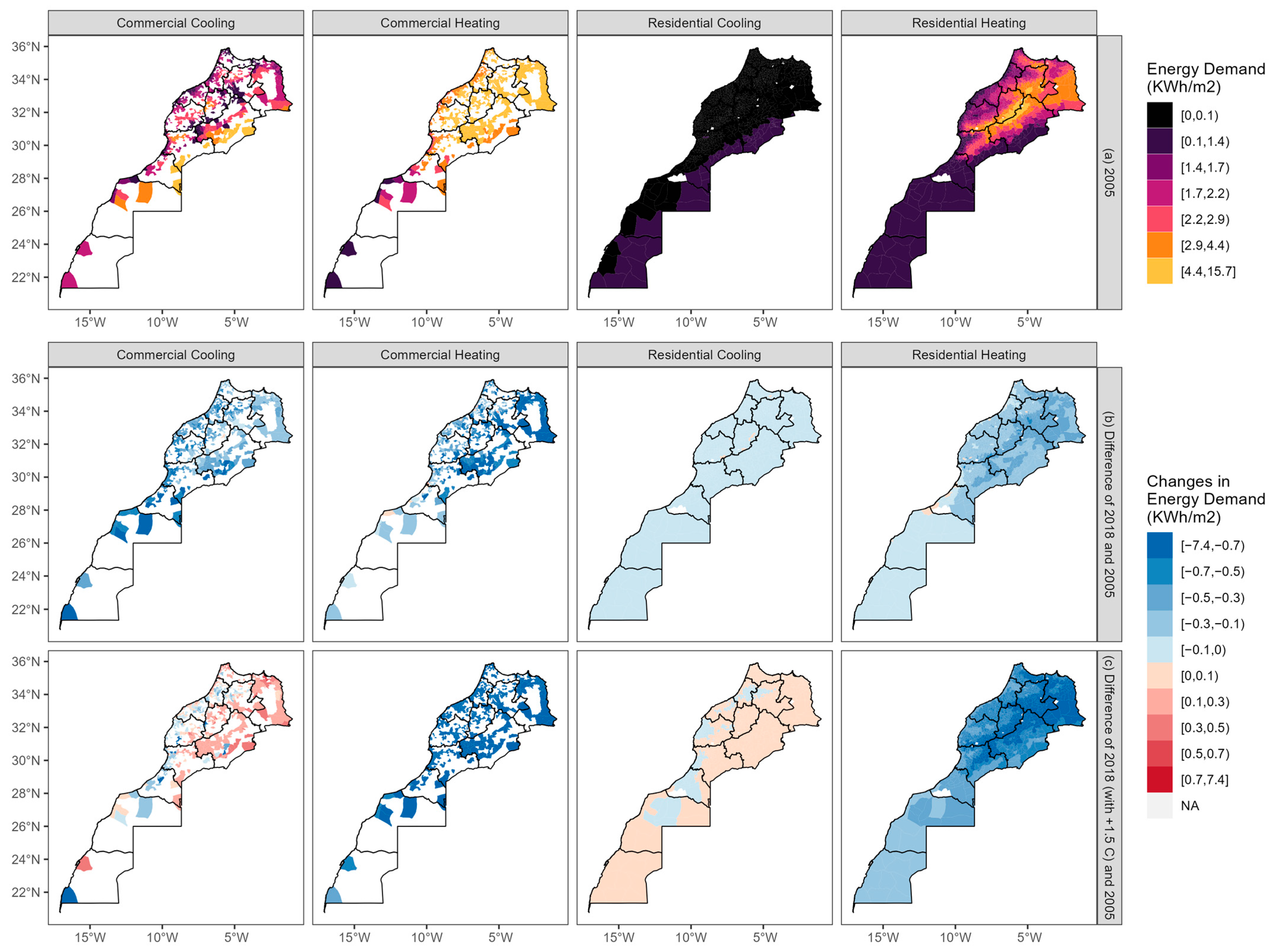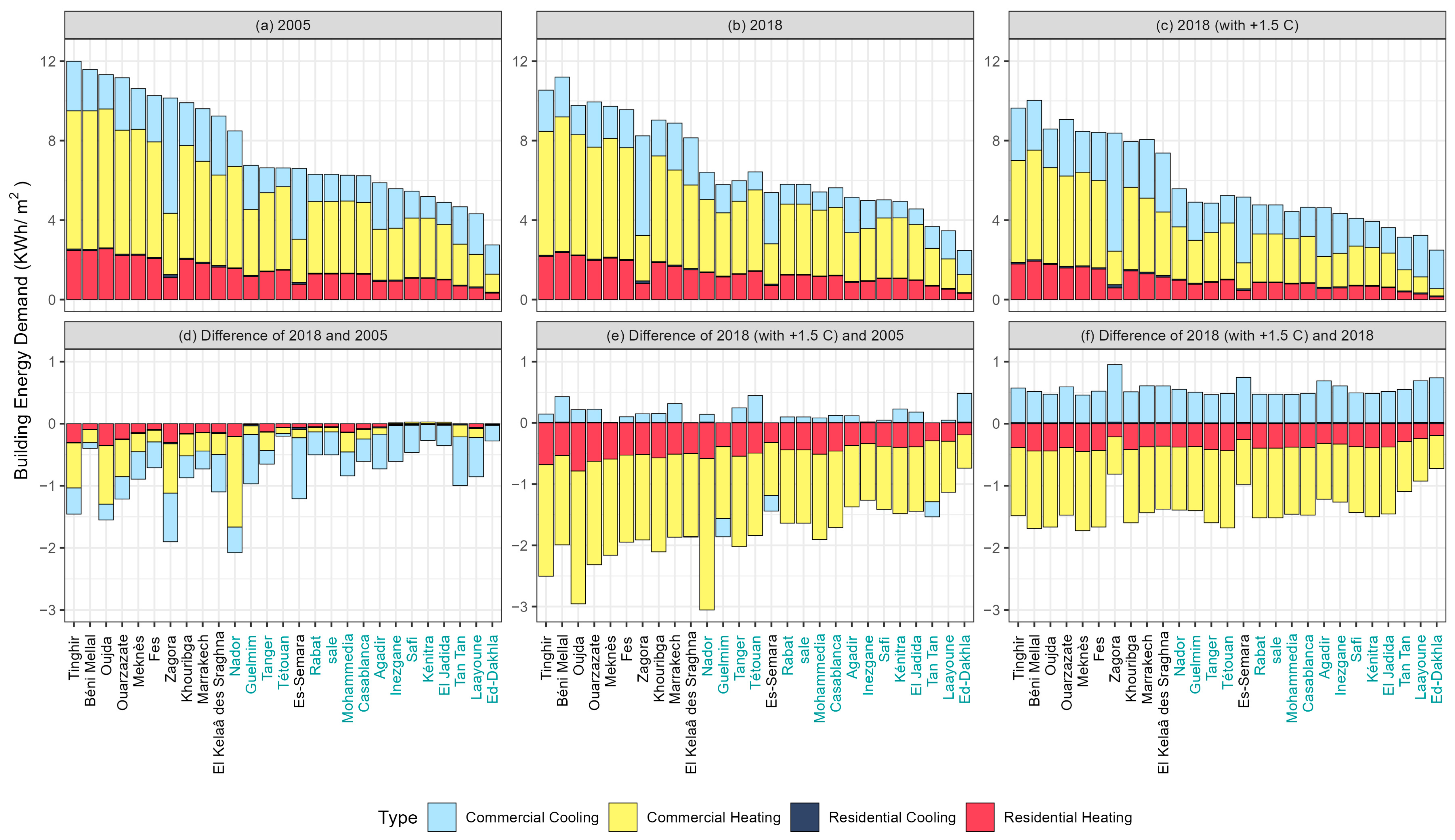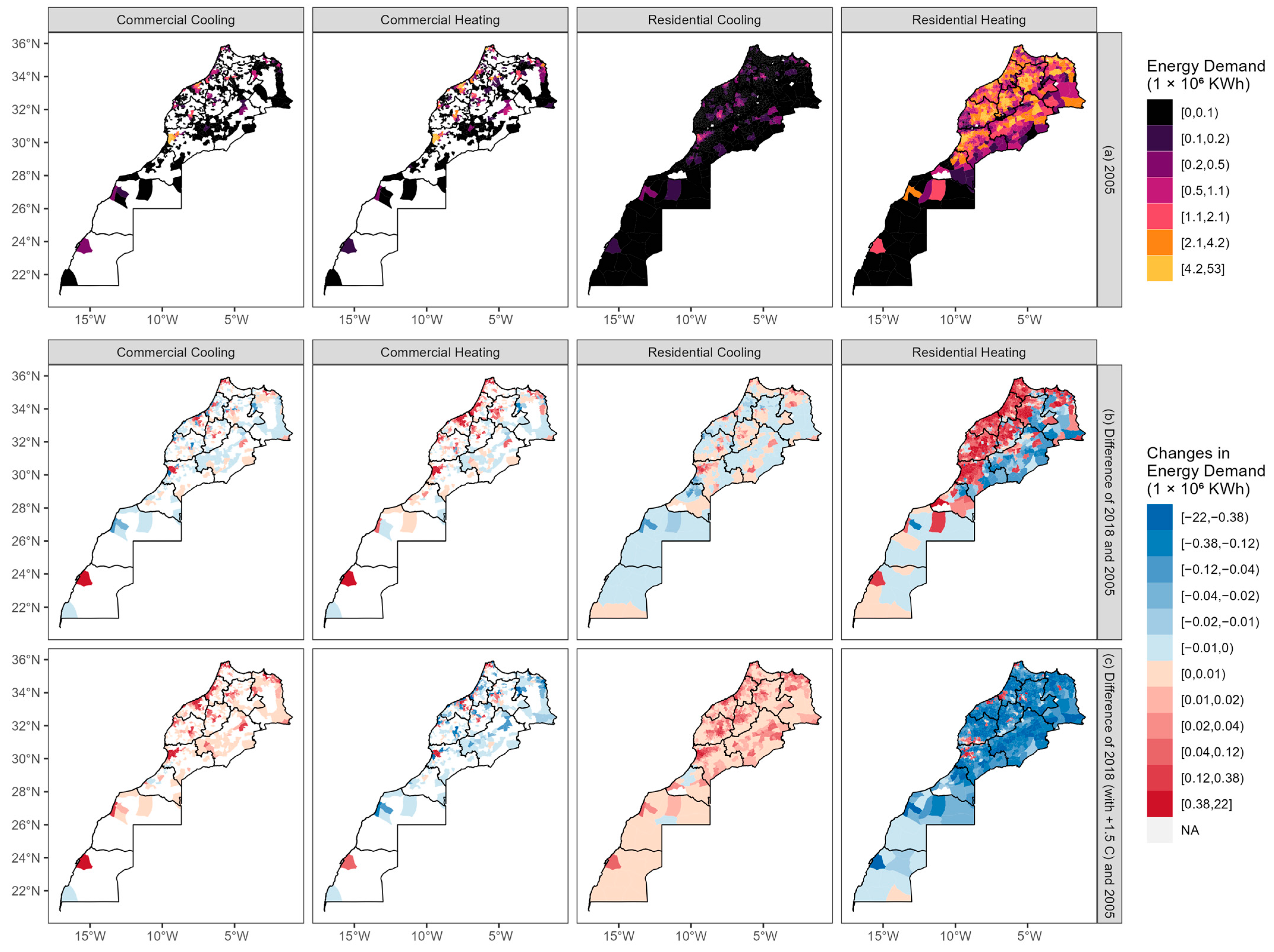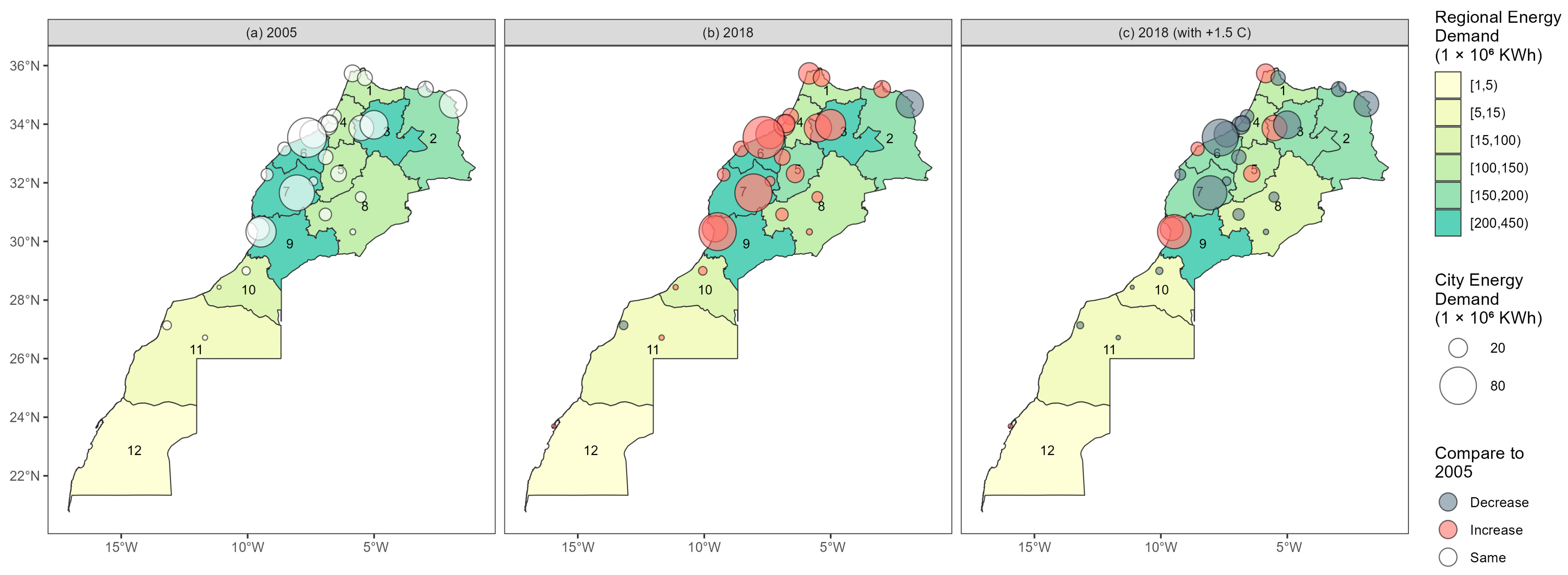The Interplay Between Climate and Urban Expansion on Building Energy Demand in Morocco
Abstract
1. Introduction
2. Materials and Methods
2.1. Study Region
2.2. The Building Energy Demand (BED) Model
2.3. Calibration
| Variable | Data Source | Reference | Resolution |
|---|---|---|---|
| Temperature data from ERA5 | Muñoz Sabater (2019) [36] | 0.1° grid | |
| Building area and building height data from GHSL | European Commission: Joint Research Centre (2023) [37] | 100 m grid | |
| Thermal conductance requirements set in the report by the climate zone | ADEREE (2010) [38] | Climate zone | |
| Estimated from the IEA energy report | IEA (2023) [39] | Country | |
| GDP per capita | High Commission for Planning [40] | Province | |
| Estimated from the IEA energy report (only for model calibration) | IEA (2023) [39] | Country | |
| Demand from IEA and the individual service price from GCAM | IEA (2023) [39]; Joint Global Change Research Institute (2024) [41] | Country |
2.4. Data Source
2.5. Data Preparation
2.6. Experiment Design
3. Results and Discussion
3.1. Impact of Temperature Variation on Building Energy Demand
3.1.1. Spatial Distribution
3.1.2. Regional Characteristics
3.2. Compounding Effect of Urban Expansion and Climate Variation on Building Energy Demand
3.2.1. Urban Expansion in Morocco
3.2.2. Spatial Variation of Building Energy Demand
3.2.3. Building Energy Demand in Major Cities
3.3. Hotspots Under a Warmer Climate
4. Concluding Remarks
Author Contributions
Funding
Data Availability Statement
Conflicts of Interest
References
- El Asri, N.; Abdou, N.; Mharzi, M.; Maghnouj, A. Moroccan Public Buildings and the RTCM: Insights into Compliance, Energy Performance, and Regulation Improvement. Energies 2023, 16, 6496. [Google Scholar] [CrossRef]
- IEA. World Energy Statistics and Balances. Available online: https://www.iea.org/data-and-statistics/data-product/world-energy-statistics-and-balances (accessed on 1 November 2024).
- Hafdaoui, H.E.; Khallaayoun, A.; Ouazzani, K.; Hafdaoui, H.E.; Khallaayoun, A.; Ouazzani, K. Activity and Efficiency of the Building Sector in Morocco: A Review of Status and Measures in Ifrane. AIMSE 2023, 11, 454–485. [Google Scholar] [CrossRef]
- UFCCC. Nationally Determined Contributions of Morocco; UFCCC: Bonn, Germany, 2021. [Google Scholar]
- IEA. Energy Policies Beyond IEA Countries: Morocco 2019; IEA: Paris, France, 2019. [Google Scholar]
- El Hafdaoui, H.; Khallaayoun, A.; Ouazzani, K. Long-Term Low Carbon Strategy of Morocco: A Review of Future Scenarios and Energy Measures. Results Eng. 2024, 21, 101724. [Google Scholar] [CrossRef]
- Filahi, H.; Drobinski, P.; Oueslati, B.; Claudel, S.; Laurent, M.-H. Rising Power System Strains despite Decreasing Heating Demand in a Warming Climate. Sci. Rep. 2025, 15, 12470. [Google Scholar] [CrossRef] [PubMed]
- Deroubaix, A.; Labuhn, I.; Camredon, M.; Gaubert, B.; Monerie, P.-A.; Popp, M.; Ramarohetra, J.; Ruprich-Robert, Y.; Silvers, L.G.; Siour, G. Large Uncertainties in Trends of Energy Demand for Heating and Cooling under Climate Change. Nat. Commun. 2021, 12, 5197. [Google Scholar] [CrossRef]
- Ürge-Vorsatz, D.; Cabeza, L.F.; Serrano, S.; Barreneche, C.; Petrichenko, K. Heating and Cooling Energy Trends and Drivers in Buildings. Renew. Sustain. Energy Rev. 2015, 41, 85–98. [Google Scholar] [CrossRef]
- Boumlik, K.; Belarbi, R.; Ahachad, M.; Mahdaoui, M.; Radoine, H.; Krarti, M. Design Optimization of Energy-Efficient Residential Buildings in Morocco. Buildings 2024, 14, 3915. [Google Scholar] [CrossRef]
- Messoudi, L.; Gouareh, A.; Settou, B.; Mokhtara, C.; Settou, N. Modeling and Forecasting Energy Consumption in Algerian Residential Buildings Using a Bottom-up GIS Approach. Energy Build. 2024, 317, 114370. [Google Scholar] [CrossRef]
- Mutschler, R.; Rüdisüli, M.; Heer, P.; Eggimann, S. Benchmarking Cooling and Heating Energy Demands Considering Climate Change, Population Growth and Cooling Device Uptake. Appl. Energy 2021, 288, 116636. [Google Scholar] [CrossRef]
- Romani, Z.; Draoui, A.; Allard, F. Metamodeling the Heating and Cooling Energy Needs and Simultaneous Building Envelope Optimization for Low Energy Building Design in Morocco. Energy Build. 2015, 102, 139–148. [Google Scholar] [CrossRef]
- Hamdaoui, S.; Mahdaoui, M.; Allouhi, A.; El Alaiji, R.; Kousksou, T.; El Bouardi, A. Energy Demand and Environmental Impact of Various Construction Scenarios of an Office Building in Morocco. J. Clean. Prod. 2018, 188, 113–124. [Google Scholar] [CrossRef]
- Kharbouch, Y. Effectiveness of Phase Change Material in Improving the Summer Thermal Performance of an Office Building under Future Climate Conditions: An Investigation Study for the Moroccan Mediterranean Climate Zone. J. Energy Storage 2022, 54, 105253. [Google Scholar] [CrossRef]
- Idrissi Kaitouni, S.; Chahboun, R.; Bouhssine, Z.; Cakan, M.; Brigui, J.; Ahachad, M. Simulation-Based Assessment of the Climate Change Impact on Future Thermal Energy Load and Indoor Comfort of a Light-Weight Ecological Building across the Six Climates of Morocco. Therm. Sci. Eng. Prog. 2023, 45, 102137. [Google Scholar] [CrossRef]
- Lachir, A.; Nia, H.A. Urban Design Impact on Local Climate and Its Consequences on Building Energy Demand in Morocco. J. Mediterr. Cities 2023, 3, 43–58. [Google Scholar] [CrossRef]
- Oualid, M.M.; Elmankibi, M.; Lamdouar, N. The Net Zero Energy Building Definition Framework: An Overview Pathway to Enhancing Sustainable Development and Mitigating Climate Change in Morocco. Procedia Comput. Sci. 2024, 236, 281–288. [Google Scholar] [CrossRef]
- Abdou, N.; El Mghouchi, Y.; Jraida, K.; Hamdaoui, S.; Hajou, A.; Mouqallid, M. Prediction and Optimization of Heating and Cooling Loads for Low Energy Buildings in Morocco: An Application of Hybrid Machine Learning Methods. J. Build. Eng. 2022, 61, 105332. [Google Scholar] [CrossRef]
- Benaomar, K.; Outzourhit, A. Exploring the Complexities of Urban Forms and Urban Heat Islands: Insights from the Literature, Methodologies, and Current Status in Morocco. Atmosphere 2024, 15, 822. [Google Scholar] [CrossRef]
- Frank, T. Climate Change Impacts on Building Heating and Cooling Energy Demand in Switzerland. Energy Build. 2005, 37, 1175–1185. [Google Scholar] [CrossRef]
- Wang, C.; Song, J.; Shi, D.; Reyna, J.L.; Horsey, H.; Feron, S.; Zhou, Y.; Ouyang, Z.; Li, Y.; Jackson, R.B. Impacts of Climate Change, Population Growth, and Power Sector Decarbonization on Urban Building Energy Use. Nat. Commun. 2023, 14, 6434. [Google Scholar] [CrossRef]
- Staffell, I.; Pfenninger, S.; Johnson, N. A Global Model of Hourly Space Heating and Cooling Demand at Multiple Spatial Scales. Nat. Energy 2023, 8, 1328–1344. [Google Scholar] [CrossRef]
- Amonkar, Y.; Doss-Gollin, J.; Farnham, D.J.; Modi, V.; Lall, U. Differential Effects of Climate Change on Average and Peak Demand for Heating and Cooling across the Contiguous USA. Commun. Earth Environ. 2023, 4, 1–9. [Google Scholar] [CrossRef]
- Bahir, M.; Ouhamdouch, S.; Ouazar, D. An Assessment of the Changes in the Behavior of the Groundwater Resources in Arid Environment with Global Warming in Morocco. Groundw. Sustain. Dev. 2021, 12, 100541. [Google Scholar] [CrossRef]
- Ouhamdouch, S.; Bahir, M. Climate Change Impact on Future Rainfall and Temperature in Semi-Arid Areas (Essaouira Basin, Morocco). Environ. Process. 2017, 4, 975–990. [Google Scholar] [CrossRef]
- Driouech, F.; Stafi, H.; Khouakhi, A.; Moutia, S.; Badi, W.; ElRhaz, K.; Chehbouni, A. Recent Observed Country-Wide Climate Trends in Morocco. Int. J. Climatol. 2021, 41, E855–E874. [Google Scholar] [CrossRef]
- Schilling, J.; Hertig, E.; Tramblay, Y.; Scheffran, J. Climate Change Vulnerability, Water Resources and Social Implications in North Africa. Reg. Environ. Change 2020, 20, 15. [Google Scholar] [CrossRef]
- Gumus, V.; El Moçayd, N.; Seker, M.; Seaid, M. Evaluation of Future Temperature and Precipitation Projections in Morocco Using the ANN-Based Multi-Model Ensemble from CMIP6. Atmos. Res. 2023, 292, 106880. [Google Scholar] [CrossRef]
- Labriet, M.; Joshi, S.R.; Vielle, M.; Holden, P.B.; Edwards, N.R.; Kanudia, A.; Loulou, R.; Babonneau, F. Worldwide Impacts of Climate Change on Energy for Heating and Cooling. Mitig. Adapt. Strateg. Glob. Change 2015, 20, 1111–1136. [Google Scholar] [CrossRef]
- Bounoua, L.; Lachkham, M.A.; Ed-Dahmany, N.; Lagmiri, S.; Bahi, H.; Messouli, M.; Yacoubi Khebiza, M.; Nigro, J.; Thome, K.J. Urban Sustainability Development in Morocco, a Review. Urban Science 2024, 8, 28. [Google Scholar] [CrossRef]
- Khalfallah, E.; Missaoui, R.; El Khamlichi, S.; Ben Hassine, H. Energy-Efficient Air Conditioning: A Case Study of the Maghreb; World Bank: Washington, DC, USA, 2016. [Google Scholar]
- Eom, J.; Calvin, K.; Clarke, L.; Edmonds, J.; Kim, S.; Kopp, R.; Kyle, P.; Luckow, P.; Moss, R.; Patel, P.; et al. Exploring the Future Role of Asia Utilizing a Scenario Matrix Architecture and Shared Socio-Economic Pathways. Energy Econ. 2012, 34, S325–S338. [Google Scholar] [CrossRef]
- Eom, J.; Clarke, L.; Kim, S.H.; Kyle, P.; Patel, P. China’s Building Energy Demand: Long-Term Implications from a Detailed Assessment. Energy 2012, 46, 405–419. [Google Scholar] [CrossRef]
- Clarke, L.; Eom, J.; Marten, E.H.; Horowitz, R.; Kyle, P.; Link, R.; Mignone, B.K.; Mundra, A.; Zhou, Y. Effects of Long-Term Climate Change on Global Building Energy Expenditures. Energy Econ. 2018, 72, 667–677. [Google Scholar] [CrossRef]
- Muñoz Sabater, J. ERA5-Land Hourly Data from 1950 to Present 2019. Available online: https://cds.climate.copernicus.eu/datasets/reanalysis-era5-land?tab=overview (accessed on 6 June 2024).
- Commission, E.; Centre, J.R. GHSL Data Package 2023; Publications Office of the European Union: Bruxelles, Belgium, 2023; Available online: https://op.europa.eu/en/publication-detail/-/publication/a1483a27-ed5d-11ed-a05c-01aa75ed71a1/language-en (accessed on 6 June 2024).
- ADEREE. Les Éléments Techniques Du Projet de La Réglementation Thermique Du Bâtiment Au Maroc; ADEREE: Rabat, Morocco, 2011; Available online: https://www.iemed.org/wp-content/uploads/2011/09/Lefficacite-energetique.pdf (accessed on 6 June 2024).
- IEA. Energy Statistics Data Browser—Data Tools. Available online: https://www.iea.org/data-and-statistics/data-tools/energy-statistics-data-browser (accessed on 6 June 2024).
- High Commission for Planning Note d’information Relative Aux Comptes Régionaux de l’année 2016. Available online: https://www.hcp.ma/Parution-de-la-note-d-information-du-Haut-Commissariat-au-Plan-HCP-sur-les-comptes-regionaux-de-l-annee-2016_a2204.html (accessed on 17 July 2024).
- Joint Global Change Research Institute. GCAM Documentation. Available online: https://jgcri.github.io/gcam-doc/demand_water.html (accessed on 31 October 2024).
- AMEE. Le Règlement Thermique de Construction Au Maroc. Available online: https://www.amee.ma/sites/default/files/inline-files/Le%20reglement%20thermique.pdf (accessed on 31 October 2024).
- Calvin, K.; Patel, P.; Clarke, L.; Asrar, G.; Bond-Lamberty, B.; Cui, R.Y.; Di Vittorio, A.; Dorheim, K.; Edmonds, J.; Hartin, C.; et al. GCAM v5.1: Representing the Linkages between Energy, Water, Land, Climate, and Economic Systems. Geosci. Model Dev. 2019, 12, 677–698. [Google Scholar] [CrossRef]
- Calama-González, C.M.; Escandón, R.; Alonso, A.; León-Rodríguez, Á.L.; Suárez, R. Building Assessment and Statistical Characterisation of the Mediterranean Social Housing Stock in Southern Spain. IOP Conf. Ser. Earth Environ. Sci. 2022, 1050, 012020. [Google Scholar] [CrossRef]
- World Health Organization 2025 data.who.int Morocco [Country Overview]. Available online: https://data.who.int/countries/504 (accessed on 28 April 2025).
- UNDESA. Population Division World Population Prospects 2024. Available online: https://www.un.org/development/desa/pd/sites/www.un.org.development.desa.pd/files/files/documents/2024/Jul/undesa_pd_2024_wpp2024_methodology-report.pdf (accessed on 28 April 2025).









| Scenario | Description |
|---|---|
| 2005 | Building heating and cooling demands under the 2005 climate |
| 2018 | Building heating and cooling demands under the 2018 climate |
| 2018 + 1.5 °C | Building heating and cooling demands under the 2018 climate + 1.5 °C |
| Service | Location | 2005 | 2018 | 2018 + 1.5 °C | |||
|---|---|---|---|---|---|---|---|
| [GWh] | Share [%] | [GWh] | Share [%] | [GWh] | Share [%] | ||
| Heating | Casablanca | 79.2 | 7.05 | 92.1 | 6.93 | 62.7 | 6.31 |
| Marrakech | 68.1 | 6.06 | 76.9 | 5.79 | 59.8 | 6.02 | |
| Inezgane | 40.1 | 3.57 | 66.0 | 4.97 | 42.5 | 4.28 | |
| Agadir | 21.0 | 1.87 | 30.6 | 2.30 | 19.4 | 1.95 | |
| Fes | 42.8 | 3.81 | 50.6 | 3.81 | 39.5 | 3.98 | |
| Oujda | 42.7 | 3.80 | 42.0 | 3.16 | 33.7 | 3.39 | |
| Morocco | 1123.4 | - | 1329.0 | - | 993.2 | - | |
| Cooling | Casablanca | 11.3 | 10.23 | 10.1 | 8.16 | 15.0 | 8.92 |
| Marrakech | 6.0 | 5.43 | 6.2 | 5.01 | 7.7 | 4.58 | |
| Inezgane | 14.0 | 12.67 | 17.2 | 13.9 | 24.4 | 14.52 | |
| Agadir | 6.8 | 6.15 | 8.1 | 6.55 | 11.1 | 6.60 | |
| Fes | 3.3 | 2.99 | 3.2 | 2.59 | 4.0 | 2.38 | |
| Oujda | 1.7 | 1.54 | 1.7 | 1.37 | 2.2 | 1.31 | |
| Morocco | 110.5 | - | 123.7 | - | 168.1 | - | |
| Total | Morocco | 1233.9 | - | 1452.7 | - | 1161.3 | - |
Disclaimer/Publisher’s Note: The statements, opinions and data contained in all publications are solely those of the individual author(s) and contributor(s) and not of MDPI and/or the editor(s). MDPI and/or the editor(s) disclaim responsibility for any injury to people or property resulting from any ideas, methods, instructions or products referred to in the content. |
© 2025 by the authors. Licensee MDPI, Basel, Switzerland. This article is an open access article distributed under the terms and conditions of the Creative Commons Attribution (CC BY) license (https://creativecommons.org/licenses/by/4.0/).
Share and Cite
Zhao, M.; Bounoua, L.; Prime, N.; Bahi, H.; Khan, Z. The Interplay Between Climate and Urban Expansion on Building Energy Demand in Morocco. Urban Sci. 2025, 9, 168. https://doi.org/10.3390/urbansci9050168
Zhao M, Bounoua L, Prime N, Bahi H, Khan Z. The Interplay Between Climate and Urban Expansion on Building Energy Demand in Morocco. Urban Science. 2025; 9(5):168. https://doi.org/10.3390/urbansci9050168
Chicago/Turabian StyleZhao, Mengqi, Lahouari Bounoua, Noah Prime, Hicham Bahi, and Zarrar Khan. 2025. "The Interplay Between Climate and Urban Expansion on Building Energy Demand in Morocco" Urban Science 9, no. 5: 168. https://doi.org/10.3390/urbansci9050168
APA StyleZhao, M., Bounoua, L., Prime, N., Bahi, H., & Khan, Z. (2025). The Interplay Between Climate and Urban Expansion on Building Energy Demand in Morocco. Urban Science, 9(5), 168. https://doi.org/10.3390/urbansci9050168






